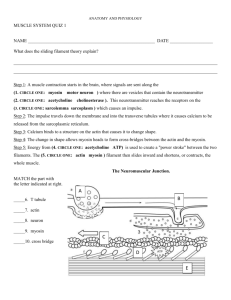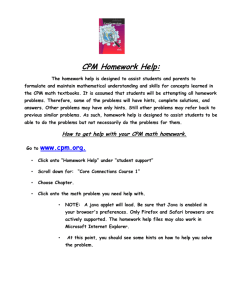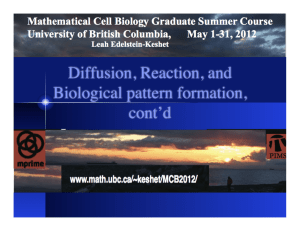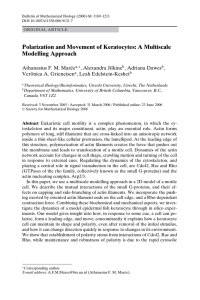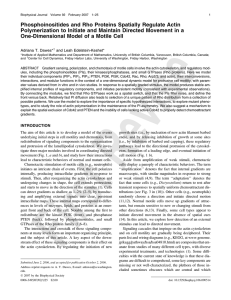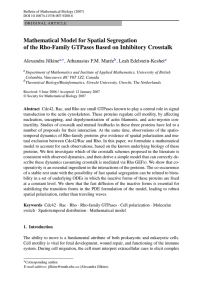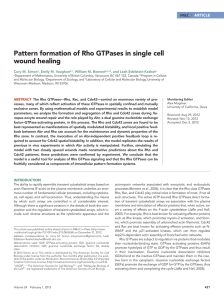Document 11151761
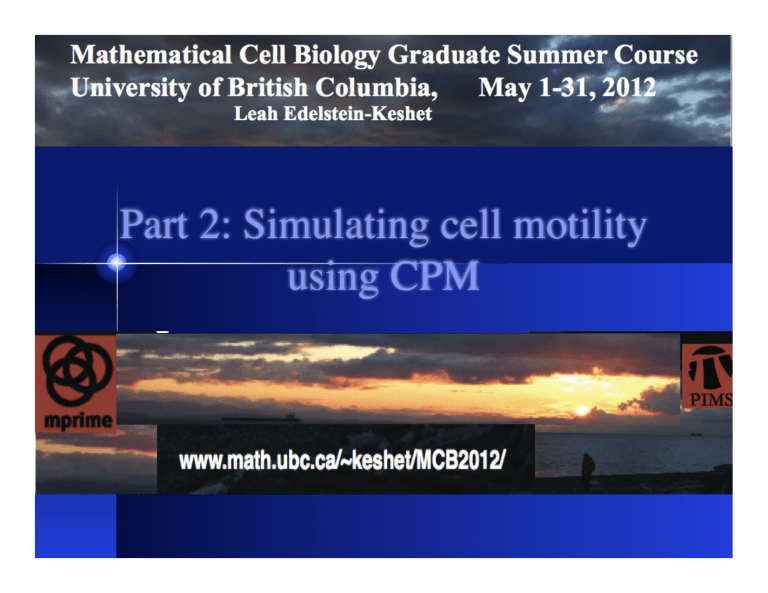
Part 2: Simulating cell motility using CPM
Shape change and motility
Resting cell
Chemical polarization
“Rear”:
(contraction)
Shape change
“Front”:
(protrusion)
What are the overarching questions?
• How is the shape and motility of the cell regulated?
• What governs cell morphology, and why does it differ over different cell types?
• How do cells polarize, change shape, and initiate motility?
• How do they maintain their directionality?
• How can they respond to new signals?
• How do they avoid getting stuck?
Types of models
• Fluid-based
• Mechanical (springs, dashpots, elastic sheets)
• Chemical (reactions in deforming domain)
• Other (agent-based, filament based, etc)
Types of models
• Fluid-based
• Mechanical (springs, dashpots, elastic sheets)
• Chemical (reactions in deforming domain)
• Other (agent-based, filament based, etc)
CPM: Stan Marée
V Grieneisen
AFM Maree
Marée AFM, Jilkine A, Dawes AT, Greineisen VA, LEK (2006)
Bull Math Biol, 68(5):1169-1211.
Mare ́ e AFM, Grieneisen VA, Edelstein-Keshet L (2012) How Cells Integrate Complex
Stimuli: The Effect of Feedback from Phosphoinositides and Cell Shape on Cell Polarization and Motility. PLoS Comput Biol 8(3): e1002402. doi:10.1371/journal.pcbi.1002402
Signaling “layers”
Cdc42 Rac
(WASp)
Arp2/3
(WAVE) (PIP2)
(uncap)
Barbed ends
Actin filaments
Cell protrusion
Rho
(ROCK)
Myosin
Rear retraction
Represent reaction-diffusion and actin growth/nucleation in a 2D simulation of a “motile cell”
More recently:
Mare ́ e AFM, Grieneisen VA, Edelstein-Keshet L (2012).
PLoS Comput Biol 8(3): e1002402. doi:10.1371/journal.pcbi.1002402
2D cell motility using Potts model formalism
“Thin sheet”
2D
Discretize using hexagonal grid
Cell interior
Cell exterior
6 Filament orientations
• compute actin density at 6 orientations
• allow for branching by
Arp2/3
Hamiltonian based computation:
Cell interior
Cell exterior
Cell volume too big
Rho, Myosin contraction
Cell volume
Too small
Pushing actin ends
Fig: revised & adapted from: Segel, Lee A. (2001) PNAS
Cell interior
Protrusion
Cell exterior
Cell volume too big
Rho, Myosin contraction
Cell volume
Too small
Pushing actin ends
Cell interior
Cell volume too big
Rho, Myosin contraction
Cell exterior
Cell volume
Too small
Pushing actin ends
Fig: revised & adapted from: Segel, Lee A. (2001) PNAS
Cell interior
Cell volume too big
Rho, Myosin contraction
Retraction
Cell exterior
Cell volume
Too small
Pushing actin ends
Each hexagonal site contains:
Cdc42 Rac Rho
Arp2/3
Barbed ends
Actin Cell filaments
Myosin
Rear retraction
6 Filament orientations
6 barbed end orientations
Cdc42 (active, inactive)
Rac (active, inactive)
Rho (active, inactive)
Arp2/3
PIP, PIP2, PIP3
Resting vs stimulated cell
Cdc42 distribution
Low High
Low High
Cdc42, Rac, Rho
Distribution of internal biochemistry
Cdc42 Rac
Rho high low
Cdc42 Rac Rho
And actin:
Filaments, Arp2/3, Tips
Low High
Actin Filaments
Cytoskeleton
Turning behaviour
Shallow gradient
Steep gradient http://theory.bio.uu.nl/stan/keratocyte/
Turning behaviour
Shallow gradient
Steep gradient http://theory.bio.uu.nl/stan/keratocyte/
Variety of shape and motility phenotypes
Effect of shape
• cell can repolarize whether or not its shape is allowed to evolve
• when shape is dynamic, reaction to new stimuli is much more rapid
What the lipids do: fine tuning
. PLoS Comput Biol 8(3): e1002402. doi:10.1371
Pushing barbed ends: extension
Mare ́ e AFM, Grieneisen VA, Edelstein-Keshet L (2012) How Cells Integrate Complex
Stimuli: The Effect of Feedback from Phosphoinositides and Cell Shape on Cell Polarization and Motility. PLoS Comput Biol 8(3): e1002402. doi:10.1371/journal.pcbi.1002402
Pushing barbed ends: retraction
10.1371
Pushing barbed ends: extension
Mare ́ e AFM, Grieneisen VA, Edelstein-Keshet L (2012) How Cells Integrate Complex
Stimuli: The Effect of Feedback from Phosphoinositides and Cell Shape on Cell Polarization and Motility. PLoS Comput Biol 8(3): e1002402. doi:10.1371/journal.pcbi.1002402
From Jun Allard’s Lecture 5:
(Simulating membrane mechanics)
CPM Metropolis:
1.
Choose edge site at random
2.
Propose to extend or retract
3.
Compute new H
4.
If Δ H < -H b keep this move
5.
If Δ H ≥ -H b accept move with probability
6.
Iterate over each lattice site randomly
Hamiltonian and Energy minimization
• Energy of cell interface
• of area expansion
• of perimeter change
Effective forces
• Effect of pushing barbed ends
• of myosin contraction
CPM parameters
“Temperature”
• This parameter governs the fluctuation intensity
• Note edge of “cell” thereby fluctuates:
Relationship between v and b: edge protrusion and barbed end density
• Consider case of no capping, no branching
• Suppose fraction (1f ) barbed ends pushing, and fraction f are not.
• Probability to extend and to retract:
Protrusion speed
• Effective speed of protrusion:
Mean velocity related to fraction f:
• Mean velocity = v = f v
0
• =
• f =v / v
0
CPM Parameters T and H b
“tuned” to known relationship of v to b
• CPM formula:
• “known” relationship
CPM Pluses
• Reasonably “easy” fast computations allow for more detailed biochemistry
• Captures fluctuations well
• Can be tuned to behave like thermal-ratchet based protrusion
• Easily extended to multiple interacting cells
CPM minuses
• Mechanical forces not explicitly described
• Interpretation of CPM parameters less direct
• No representation of fluid properties of cell interior, exterior
• Controversy of application of Metropolis algorithm to non-equilibrium situations.
Comparative study
• CPM Mechanical cells
Andasari V, Roper RT, Swat MH, Chaplain MAJ (2012) Integrating Intracellular Dynamics
Using CompuCell3D and Bionetsolver: Applications to Multiscale Modelling of Cancer Cell
Growth and Invasion. PLoS ONE 7(3): e33726. doi:10.1371/journal.pone.0033726

